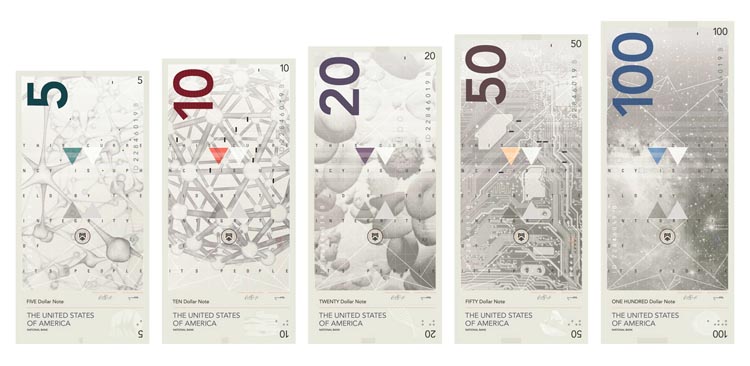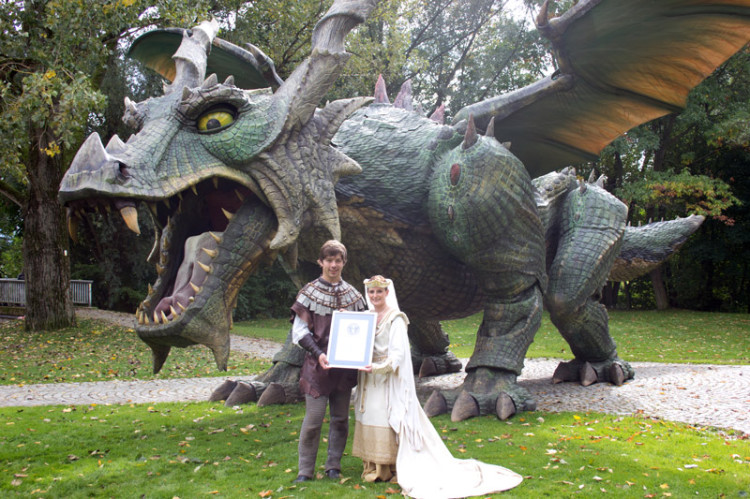Well this is a cool video. Horror movies have changed a lot in the past 122 years (hell, I didn’t know film has been around that long). Brazilian film critic and editor Diego Carrera has created a fascinating visualization of that evolution by creating a video with a short clip of one horror movie from every year starting in 1895 and ending in 2016. I was glad to see Halloween make the cut in this video, as it’s my all-time favorite horror movie. I’ve lost count of how many times I’ve seen the film, but one thing remains the same no matter how often I see it: I still get scared shitless. I know exactly when Michael is going to strike. How he’s going to kill his victims. That he’s a sadistic asshole with a perverse sense of humor (seriously, he kills Bob and then pretends to be him in a ghost costume to fool his girlfriend Lynda whom he goes on to kill). It’s pretty amazing to think that Carpenter helped usher in the slasher genre by creating the movie on a shoestring budget. More, it’s a testament to the strength of his directorial ability that the movie largely holds up over the decades. Sure, certain aesthetics are different today (landlines with those damn cords that always get tangled up; fashion; vehicles, etc), but it wouldn’t take much tweaking of the movie to make it fit into the 21st century. Even the dialogue wouldn’t need much changing. Of course it wouldn’t fit well with today’s approach to horror movies since there was no blood, and filmmakers today love their blood spatter. I wish modern movie makers would take a few notes from the movies of yesteryear. Don’t know about anyone else, but I could do with less gore and blood and more tension and suspense in my scary movies.
Hollywood
Excitement level: Tepid
My love of superheroes extends beyond comic books and trade paperbacks. I like playing superhero video games (my favorite is Spider-Man: Web of Shadows), watching superhero television shows (CW’s The Flash is arguably my favorite), and of course, watching superhero movies. I love me some superhero movies. For the longest time, my favorite was Sam Raimi’s Spider-Man 2 (yes, I’m a fan of Tobey-as-Spider-Man although Andrew Garfield did a good job too), but it was supplanted by the first Avengers movie, which hit *all* the notes I was looking for in a superhero movie (it didn’t hurt that my favorite comic book has been the Avengers for the last several decades). IMO, it was damn near perfect (it could have used another woman or two on the team, and at least one PoC). Aside from Avengers, there have been multiple superhero movies I consider among my all-time favorites, such as The Dark Knight, Iron Man, The Amazing Spider-Man, and X-Men: First Class. I really wanted to add Man of Steel to that list but I can’t. And I’m worried that I won’t be able to add Batman vs Superman to that list either bc based on Zack Snyder’s work on Man of Steel, my excitement level is lukewarm.
So you don’t understand the hubbub around #OscarsSoWhite?
Ok, so I read this comment on the Facebook page of a Root article on the lack of diversity in the Academy award nominations:
I’m just curious as to why people freak out and scream “Racism!” just because no black films were chosen. Maybe the committee just didn’t think they were good enough. Maybe I’m kinda playing devil’s advocate here but I’m genuinely curious.
This person clearly doesn’t understand why people (largely, though not exclusively, black folks) are crying “Racism!” over the Oscar nominations. People like this do not understand what the big deal is bc to them, these are just awards. They can’t seem to see beyond the awards and see the deeper problems. Or maybe they haven’t tried to view the world outside the lens of their privileged experiences. In any case, even though people like this are being blatantly racist (I mean, come the fuck on with this “black people just weren’t good enough” bullshit. Because white people, by default *are* good enough?!), I’m going to give a response that treats such inquiries in good faith (don’t ask me why). The following is my response to the queries of the above commenter about why African-Americans take issue with #OscarsSoWhite:
Continue reading “So you don’t understand the hubbub around #OscarsSoWhite?”
Oscars not so white after 2020?
“The award for Best Picture goes to Straight Outta Compton!”
“The Oscar for Best Actress goes to…Naomie Harris, Spectre!”
“The Best Actress award goes to Adepero Oduye, The Big Short!”
“And the award for Best Director goes to Ryan Coogler, for Creed!”
“And the Oscar for Best Actor goes to Michael B. Jordan, for Creed!”
“And the Best Actor award goes to Idris Elba, for Beasts of No Nation!”
“The best actress award goes to…Jada Pinkett Smitth, Magic Mike XXL!”
“The best actor award goes to John Boyega, Star Wars Episode VII: The Force Awakens!”
Were you hoping to hear any of the above at the 88th annual Academy Awards on February 28? I hate to be the bearer of bad tidings, but it’s not going to happen, bc no black actors or directors have been nominated for an Academy Award this year. Guess we have to dust off the #OscarsSoWhite hashtag.
Five of my favorite horror movies

It’s the most fearful time of the year
With kids in scary costumes
And Hollywood filling you up with much fear
It’s the most fearful time of the year.
It’s the scar-scariest season of all
With those Satanist readings and de
monic meetings
When pagans come to call
It’s the scar-scariest season of all.
(apologies to Andy Williams for tweaking/butchering his widely loved Xmas song)
Obviously, this post is a Halloween-themed post. I don’t really think this time of year is particularly frightening (no more so than any other time of year). I was just channeling the whining of far-right fundie whackaloons. We all know how whiny and double-extra irrational they get around this time of year. I’m sure we’ll hear something from Pat Robertson about the dangers of dressing kids up or demonic energies (or other such nonsense). Me, I figured I’d take this time to list 5 of my favorite horror movies. Note that I said 5 of my favorite, rather than Top 5. The reason for this? Most of the movies I would even think to list in a Top 5 are ones I haven’t seen in a very long time. It’s hard for me to rate one movie over another when I haven’t viewed it in a while and don’t remember enough details. The only caveat here is that I *do* have a favorite movie, which I’ll be counting down to (it’s a movie I’ve seen repeatedly and it left an indelible mark in my mind, so I remember a lot about it). Here are four of my favorites, in no particular order:
A bit more gender diversity from Marvel Studios

One of the many upcoming projects from Marvel Studios is the long-simmering Doctor Strange movie. In the comics, Doctor Stephen Strange was a talented yet arrogant neurosurgeon who sought to regain the use of his hands after a tragic accident. He traveled around the world seeking the best doctors to repair his hands, but all to no avail. Despondent, distraught, broke, and homeless, Strange continued his search and eventually learned of the Ancient One, a hermit in the Himalayas who might be able to assist him. While he is initially rebuffed by the hermit, Strange eventually proves his worth and the Ancient One agrees to help the doctor, though not by repairing his hands. Instead, he trains him in the use of the mystic arts and eventually grants him the mantle of Sorcerer Supreme.
Why all this background about Dr. Strange and the Ancient One? Weeeeell, Marvel is currently in the casting stage for the upcoming Dr. Strange film. They already have Benedict Cumberbatch lined up to play the arrogant, former neurosurgeon, and they might be close to picking someone to play the Ancient One. And they’re thinking outside the box on this one. In a move that many (myself included) see as a positive step, actress Tilda Swinton is in talks to play the Ancient One:
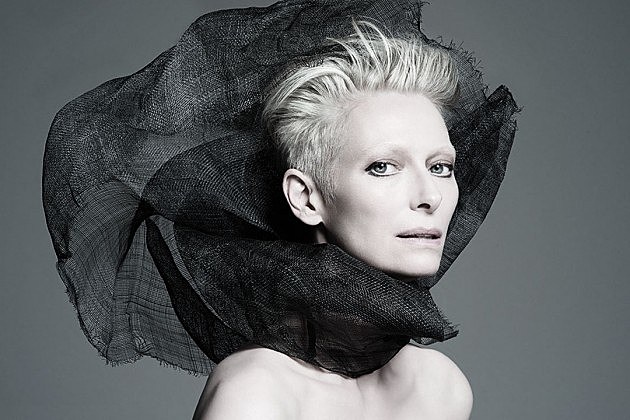
The Ancient One is a hundreds year old mystic who has mastered magic and travels the Earth, battling demons, later settling in the Himalayas with an order of monks. In the comics, The Ancient One was an older, Tibetan man, — and earlier in the film’s production, they had talked with Ken Watanabe, Morgan Freeman and Bill Nighy for the role — but the character’s identity is being altered slightly for the film. In the film, the character will train the villainous Baron Mordo before sensing evil in his heart and turning to mentor Dr. Stephen Strange, eventually bestowing on him the powerful Eye of Agamotto.
Swinton’s casting is exciting for a variety of reasons. The first, and most obvious, is that the Marvel Cinematic Universe (and superhero movies as a whole) don’t need another all-powerful male character; there are plenty of those. It’s honorable that Marvel was looking at a group of actors that were ethnically diverse, but even better than they were thinking further outside of the box to cast a woman.
For all that Stan Lee’s work at Marvel was groundbreaking and noteworthy, he was still writing comics at a time when women were not well represented in pop culture because the socially approved role of women was homemaker or housewife. Yes, Stan created the Wasp, the Scarlet Witch, and the Invisible Girl, but they were frequently relegated to the role of damsels-in-distress or the girlfriend (and dear Odin, Stan wrote many a cringe-worthy scene involving female superheroes). Meanwhile, their male counterparts rarely (if ever) received such treatment. No, male characters in the various titles written by Stan got to be more than the boyfriend. They didn’t have to worry about being hogtied, captured, and held hostage waiting for a savior to swoop in and free them. The men got to steer the plot. The women were treated as window dressing. So it probably never crossed Stan’s mind that a woman could serve as mentor to Doctor Strange.
It’s sad in a way. Like so many people back then (and plenty today), Stan Lee’s creativity was constrained by an adherence to rigid gender roles imposed by society-he was thinking inside the box. As a result of such limited thinking, Stan Lee’s comics did not-contrary to a long-running narrative about Marvel Comics-“reflect the world outside your window“. How could it, when the Marvel Universe as created by Stan was populated by a sea of white, male faces (with a few women and a smattering of black folk included for token attempts at diversity)? That’s not what the real world has ever looked like.
That’s one of the reasons I like the idea of casting Tilda Swinton as the Ancient One. Women exist in the world outside my window (and everyone else’s). Yes, some women are housewives and homemakers, but they’re also sanitation workers and teachers, doctors and dental hygienists, lawyers and judges, astronauts and chemists, sociologists and electricians, librarians and painters, writers and activists, and so much, much more. That’s why it makes sense to me for Hollywood executives to widen the pool of potential candidates for movie roles. Instead of treating men as the default, they’re slowly beginning to realize that women can do the same things as men (hello Charlize Theron in Fury Road), and that includes playing the role of wise and aged mentor to the master of the mystic arts.
Hollywood has the power, now where is the responsibility?
Voltaire said it first. Winston Churchill said a variation of it. Many people today associate it with the spectacular Spider-Man.

As applied to a certain Marvel Comics wall-crawler, the phrase conveys the idea that the acquisition of superpowers entails a responsibility to use those powers wisely. Here in the real world, despite the absence of super-powered beings, humans can (and regularly, do) acquire great power. Power in the form of social or political influence, such as you find in politicians or political pundits. Power as possessed by officers of the law, who are empowered by the state to enforce the law, limit civil disorder, and protect property (and who also have the state-sanctioned right to the use of force). Power as wielded by those of great wealth, such as those who make up the 1%. Unfortunately, as if to echo comic book supervillains, many of those who wield power in the real world do not do so responsibly. This can be seen in the politicians who endorse discrimination and bigotry or the law enforcement officials who-often acting upon racial biases-take the lives of women and men of color. It can also be seen in those uber-wealthy individuals who are more concerned with acquiring more and more wealth at the expense of the people who work for them. In all those cases, it could be argued that the individual is acting in their own self-interests. That is a fine motivation and there is nothing inherently wrong with that. What is problematic is when people who wield power choose to do so, and in the process (whether through ignorance or outright malice) directly or indirectly bring harm to or cause the suffering of others. Given the impact their actions can have on the lives of others, it behooves these individuals to use their power wisely and responsibly.
Bigoted politicians.
Biased police officers.
Apathetic people of wealth.
These are not the only people to misuse the power they have. From its humble beginnings through the modern era, Hollywood has used its power and influence in ways that help white people maintain their dominance in the entertainment world*. Nowhere is this more evident than in Hollywood’s love of whitewashing. What is whitewashing? From the Stop Whitewashing Tumblr:
Whitewashing is the practice in which a person (director, producer, a fan, etc.) takes a character who is originally of color in canon work, and replaces them with a white actor or a white FC claim (role-playing games.) (read more posts on whitewashing here)
It is also used to describe the entertainment industry’s attempt to make a PoC character look more “white” in order to appeal to the white masses.
Another Hollywood problem with regard to ethnicity is racebending:
Even if you’ve never heard of Hollywood whitewashing, chances are you’ve seen it anyway. It’s a kind of casting where film studios have placed white actors in lead roles under the assumption that the majority of Americans would rather see a white face than a non-white one—despite what the role calls for. And while Hollywood may not resort to putting actors in blackface anymore, the practice of just bending the race of a character is not an uncommon one. Hence, Jake Gyllenhaal playing a Persian.
The major problem with racebending and whitewashing—aside from, you know, it being deeply offensive—is that it takes roles from actors who actually are of that ethnicity/race. In turn, they get stuck with minor roles that only serve to supplement the story of the white lead, or with stereotyped roles. For instance: If you’re Middle Eastern, you’ll be cast as a terrorist.

White people are not the only people who exist in the world. They are not the only people who exist in Hollywood. They are not the only ones who watch movies. But a look at the history of racebending and whitewashing in Hollywood shows the extent to which the motion picture industry exhibits an overwhelming white (and male) bias. This history continues through the present day. Come take a walk with me from the not-that-distant past to the not-that-distant future as I cover a metric fuckton of movies where Hollywood engaged in racebending or blackface (also yellowface and brownface).
****
We interrupt this post to note that I do not hate white people. Nowhere have I said this in this post. Nowhere have I said this in meatspace (what some refer to as the real world, which is silly, bc online is not some alternate world, it’s part of the “real world”). Again, I do. Not. Hate. White. People. I don’t dislike white people either. That would be prejudiced and bigoted (though not racist, as there is no institutional power backing bigotry or prejudice against white people). I am pissed off at the system that shows such a preference to white people. Get it? The. System. I only say this bc there are always dunderheads who think complaining about racism means that someone hates white people, and I’m sure that someone will still think this despite this disclaimer. If you do still feel this way, even after reading this, I’ve got nothing for you other than this: you either suck at reading comprehension, you’re a raging fuckhead, or both.
****
Hollywood’s love of racebending reaches back to its very beginnings with the 1915 release of D. W. Griffith’s virulently racist silent film The Birth of a Nation. The movie follows two families (one pro-Union, the other pro-Confederacy) in the post-Civil War era of Reconstruction. A technical masterpiece that is still hailed for its filmmaking innovations, Griffith’s film depicted white actors in blackface, and reinforced the racist idea of black people as subservient laborers and insatiable sex hounds who sought to rape white women.
It shows Southern whites forming the Ku Klux Klan to defend themselves against such abominations and to spur the “Aryan” cause overall. The movie asserts that the white-sheet-clad death squad served justice summarily and that, by denying blacks the right to vote and keeping them generally apart and subordinate, it restored order and civilization to the South.
“Civilization”= black people being enslaved and treated as subhuman creatures with few, if any, rights. There’s a part of me that wants to watch this movie one day, just to get a sense of how rabidly racist Griffith was. But then there’s another part of me that is content to just read the absolutely horrible reviews of the movie. Lest anyone think that The Birth of a Nation had no effect on moviegoers of the day, it inspired the first Ku Klux Klan revival by William J. Simmons. Oh, and then there were these little things called riots that broke out in the wake of the film’s release. I really feel like I need a shower after reading about this movie. Maybe two showers.

1927 saw the release of The Jazz Singer, which saw Al Jonson play a Jewish man who rejects his heritage to live out his dream of being a jazz player. In blackface. The most popular entertainer of his day, Jonson’s performance received positive reviews from white and black viewers. In writing about Jonson’s performance, Harlem’s Amsterdam News wrote “every colored performer is proud of him”.

At the height of his popularity, Fred Astaire donned makeup to perform an extended solo in the 1936 film Swing Time. Astaire may have intended his performance to be an homage to Bill Robinson, a man whom he admired, but it is no less racist for his intent.

In addition to blackface, Hollywood has a history of yellowface-using makeup on white performers in an attempt to make them appear Asian. The 1937 film The Good Earth (an adaptation of the novel by Pearl S. Buck) saw every single main character (all of whom were white, of course) donning makeup and prosthetics to appear Chinese. In writing about the film, Tanya Ghahremani says:
The story goes that the original vision for the film called for a cast of actors and actresses of Chinese descent, but the studio, MGM, didn’t think that would make for a successful film. Instead, they cast a white actor, Paul Muni, as the lead, figuring that audiences would be more inclined to see a white man headlining the picture. Due to the Hays Code that was in effect at the time—it enforced racial segregation for romantic relationships in films—they had to cast a white actress as his leading lady, and thus Luise Rainer joined the cast. Yikes.
Yikes indeed. No white bias to be seen here. Not. At. Alllllllllllll.

In 1938, Judy Garland performed in blackface in the movie Everybody Sing.
Judy Bellaire, played by Judy Garland, is the center of trouble at her exclusive private and very conservative school. She is expelled when she starts singing in a Jazzy style in her music class. Mayhem ensues as she returns home to her actress mother, playwright father, dysfunctional Russian maid (Fanny Brice) and tries out as a black face singer in a musical.
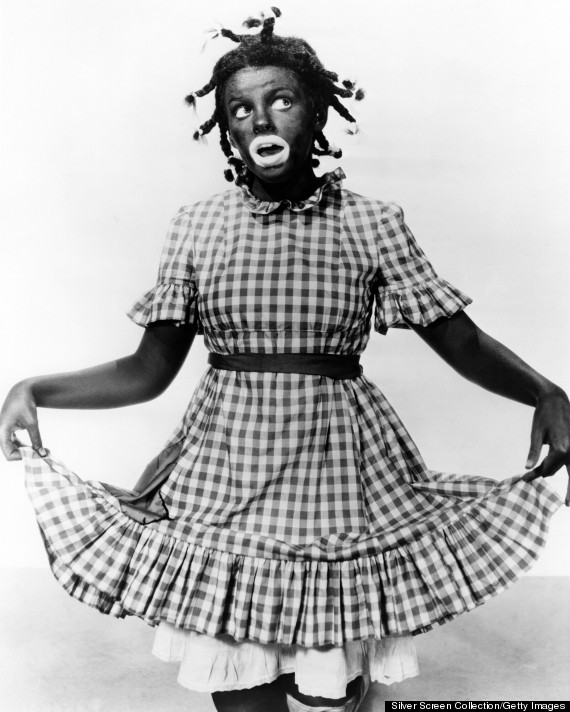
Hollywood’s history of yellowface struck once again in the 1944 film Dragon Seed, which saw iconic actress Katherine Hepburn don yellowface to portray a Chinese woman named Jade.
The lives of a small Chinese village are turned Upside down when the Japanese invade it. And heroic young Chinese woman leads her fellow villagers in an uprising against Japanese Invaders.
I think that should read “A heroic young white woman in racist yellowface plays a savior character who leads her fellow villagers in an uprising against Japanese invaders because casting an actual Chinese woman was out of the question and having her be a savior character? Pshaw! That’s the domain of white people only.”

I’d like to take this moment to shout a hearty FUCK YOU to Hollywood. This racist shit disgusts me and I’m not even halfway done with this post.
Ok. Aaaaaaaaaand release.
1954’s Apache saw Burt Lancaster being passed off as an American Indian by way of a really awful tan. Really? They couldn’t have gotten oh, say, an actual American Indian to play the role? Nah, because Hollywood was all about white people. Even when telling stories about the lives of People of Color (which I’m guessing didn’t happen very often.
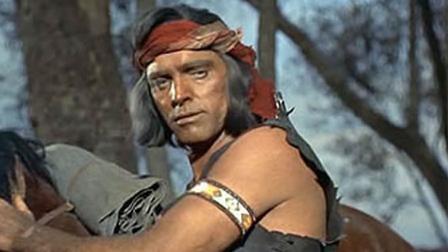
Two movies in 1956 made use of yellowface: The Conqueror and The King and I. In the former, John Wayne played Genghis Khan by wearing makeup (it’s often ranked as one of the worst films of all time, and with lines like “I am Temujin Barbarian… I fight! I love! I conquer… like a Barbarian!” I can understand why). In the latter movie, the not-Asian-at-all Yul Brynner took on the role of King Mongkut of Siam; a role in which he was covered in makeup to appear Asian.
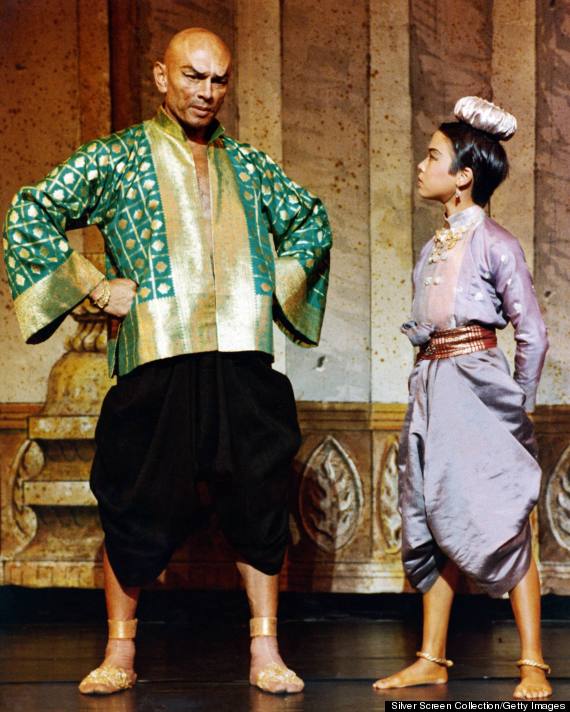

The Teahouse of the August Moon is a 1956 film featuring the legendary Marlon Brando as a translator from Okinawa. Yeah. Like other movies on this list, the role should have gone to someone who is actually of the ethnicity called for in the script. Instead of employing an actual person of Japanese ancestry, they chose to put Brando through hours of daily makeup.

Similarly, Charlton Heston’s 1958 film Touch of Evil saw the actor don pounds of dark makeup to appear Latino so that he could play the role of Miguel Vargas, a Mexican DEA agent.
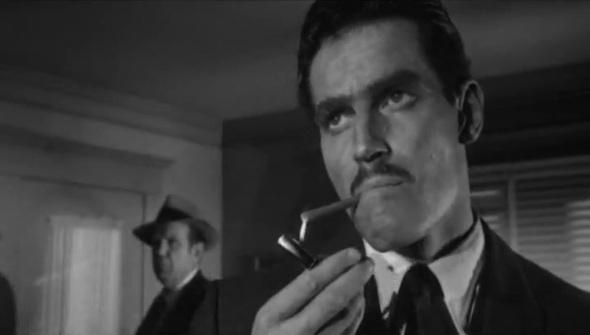
In 1961, Hollywood released three movies that showed it was still making use of racebending and makeup to portray white men as people of other ethnicities. Tony Curtis played an American Indian soldier in the movie The Outsider.
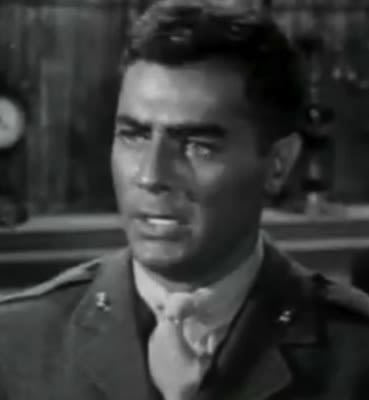
Meanwhile, in Breakfast at Tiffany’s, Mickey Rooney played Japanese photographer I.Y. Yunioshi in a puke-inducing example of racebending. Rooney’s portrayal was laden with racist stereotypes, which would have made the movie offensive even if a Japanese actor had been cast.
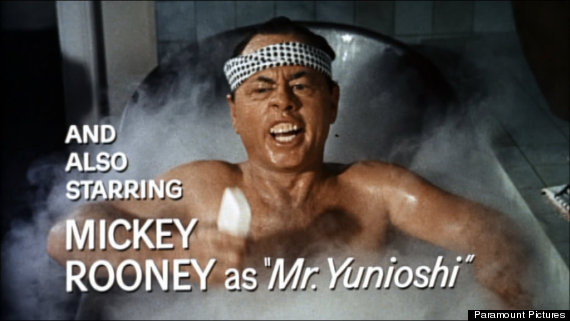
Last but not least, Natalie Wood-who is not of Puerto Rican descent-played the Puerto Rican lead in West Side Story.
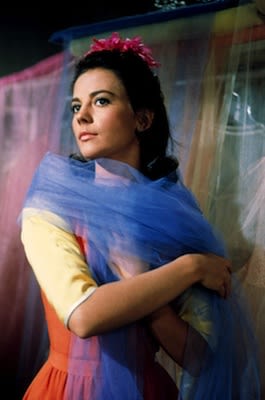
Elizabeth Taylor, considered one of the Hollywood greats, played the Egyptian Queen Cleopatra in the 1963 film Cleopatra. Iconic though the role may have been, she was still a white person being passed off as a Person of Color.

Next up–Laurence Olivier as Othello. Olivier played the black character in the 1965 movie Othello, for which he won an Oscar. Despite being released during the Civil Rights Movement, I guess no one thought to find an African-American performer to play the role of Othello.

Blackface. Yellowface. Hell, there’s even brownface, as seen in the 1968 film, The Party, starring Peter Sellers. “From the creators of the Pink Panther comes a film where we didn’t care that brownface is racist as shit it was nigh-unto impossible, impossible I tells you, to find an actual Indian actor. We searched far and wide. Like, outside-our-zip-code far.”

Answer: A 1983 film starring Eddie Murphy and Dan Aykroyd (with the latter in blackface with dreadlocks).
Question: Ummm, what is the racist film ‘Trading Places‘?
Ding! Ding! Ding! You win a No-Prize!

Next up is 1986’s Soul Man. Plot synopsis: Pampered teen with dreams of attending Harvard dons blackface to receive a full scholarship, bc it’s that easy for a black person to get into Harvard, and no one there ever does a background check on students. Who the hell thought this was a good idea?

By Odin, will this list ever end? If it takes much longer, I’m going to need one of Idunn’s golden apples so I can live long enough to finish.
Next up on the list is a movie whose creators thought it was a good idea to cast Jennifer Connelly as the El Salvadoran Alicia Nash in 2001’s A Beautiful Mind. Psst. Hey you. Yeah, I’m talking to you aforementioned creators. This was not a good idea.
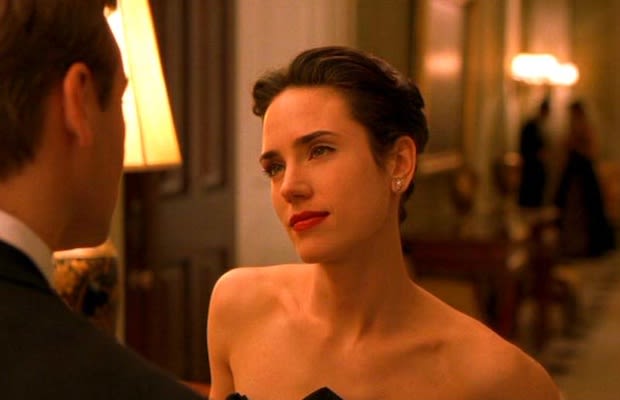
In 2007, Mena Suvari starred in Stuck, a movie based on the true story of Chante Jawan Mallard, an African-American woman who committed a hit-and-run. Suvari is a white woman. For the movie, she had her hair done up in cornrows. Because nothing says “hey I’m a white woman playing a role that should have gone to a black actress, but hey, you viewers won’t know a thing bc cornrows.”

Mariane Pearl may have hand-picked Angelina Jolie to play her in 2007’s A Mighty Heart, but it doesn’t change the fact that Jolie had to wear makeup to appear as the mixed race Pearl.
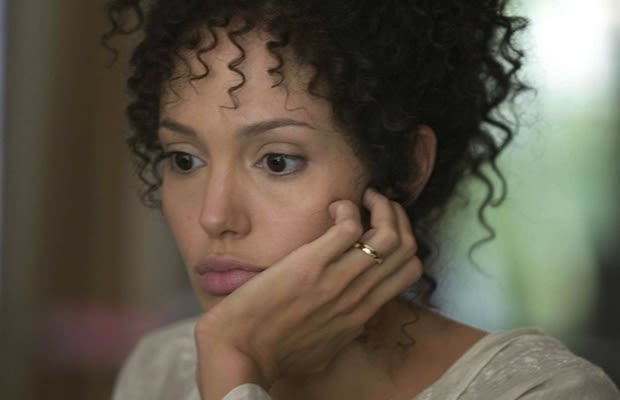
2008’s Tropic Thunder featured Jack Black, Ben Stiller, and Robert Downey, Jr. The latter performed in blackface. Yeah, I thought blackface was something consigned to the dustbins of history. Or, you know, something Hollywood left behind in the latter half of the 20th century. I’m wrong once a month, so this is probably my February moment of wrongness.

How does Hollywood adapt a non-fiction book about a group of super-duper intelligent MIT and Harvard students who are mostly Asian-American into a film with white leads? I dunno. I think it’s white bias all the way down in 2008’s 21. But hey, some background characters were Asian. That counts for something. Right? (the answer to that rhetorical question is a resounding NO).

Canadian white guy Justin Chatwin as the Japanese manga character ‘Goku’? I guess the creators of 2009’s Dragonball: Evolution thought it was a good idea. Me? This qualifies as not-a-good-idea material. But then, I try to avoid perpetuating racism where I can. Hollywood doesn’t seem terribly concerned with that though.

Prince of Persia was a videogame adapted into a live-action theatrical film (are videogame to movie adaptations ever good?) in 2010’s Prince of Persia: Sands of Time. The lead role of Dastan went to Jake Gyllenhaal. What…they couldn’t find an Iranian actor anywhere? Did they even look?
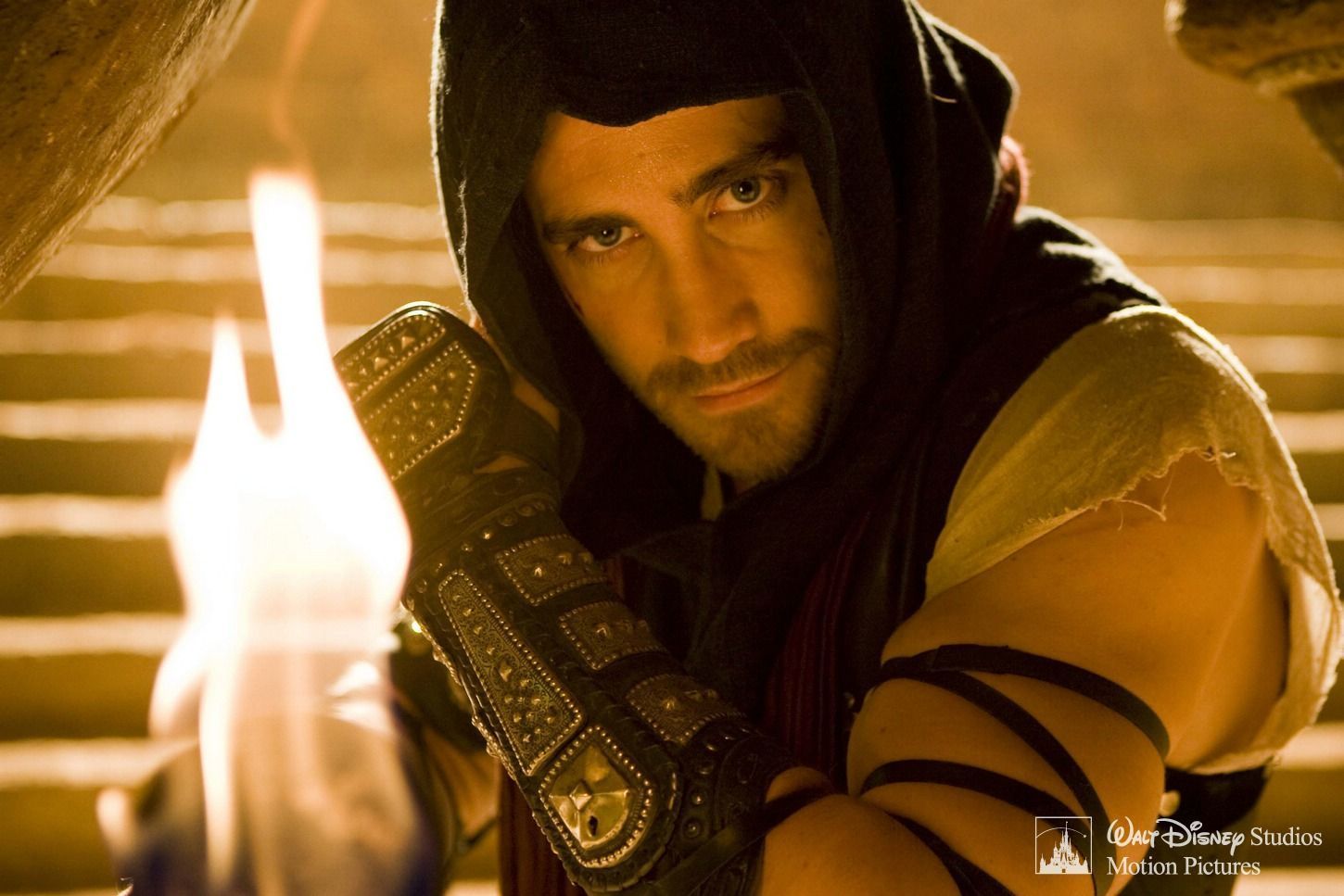
Now we turn to a movie that is responsible for bringing racebending to my attention. Even though I wasn’t familiar with the animated show that served as the inspiration for 2010’s live-action The Last Airbender film, once I read reviews, I came to understand-somewhat-the problems that many people had with the film. My understanding grew exponentially once I watched the entire series (and as I gained a greater understanding of the racism which continues to exist in USAmerica), which still remains my favorite animated series of all time. I literally do not think I have a single complaint about the series (and if you’ve ever watched a movie with me, you know I can critique the hell out of a film). I remember binge-watching multiple episodes. We’re talking 5, 6, 7 straight hours of episode after episode. I recall nights (actually they were mornings) when I had to make myself go to sleep, even though I wanted to watch more episodes. That show is hands down THAT. FUCKING. GOOD. And the live-action film should not have racebent Sokka and Katara. The characters in the animated series were not white. Notice how the villain in the movie is portrayed by a Person of Color while the protagonists are played by white people? It’s turtles white bias all the fucking way down (see here for more on the phrase “it’s turtles all the way down”; those familiar with the ridiculous cosmological “argument” for the existence of Yahweh-known in some circles as the Judeo-Christian god of the Bible-may be familiar with the phrase).
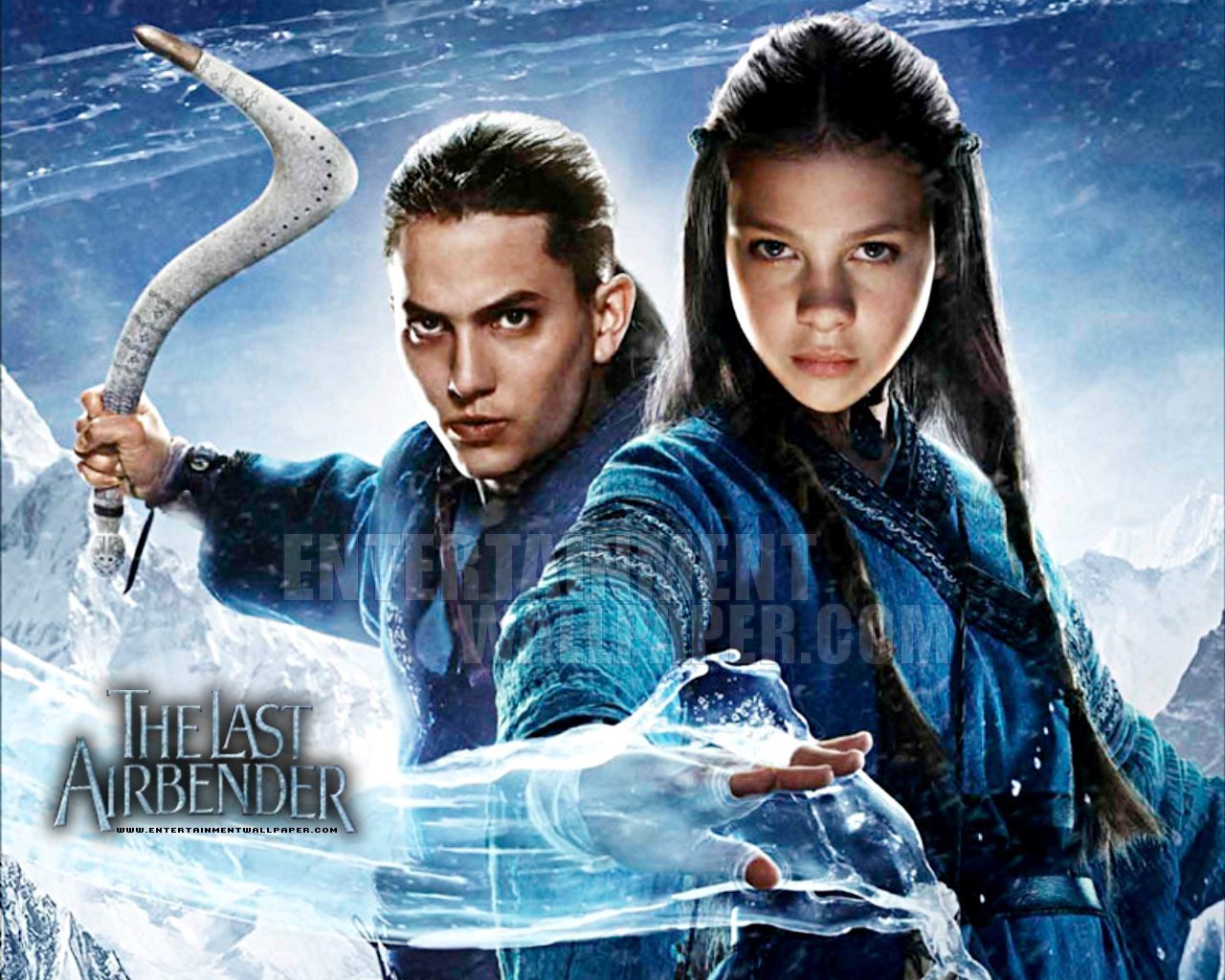
The 2011 film, Drive, featured actress Carey Mulligan who played a character intended to be an early 20s Latina. Mulligan is not a Latina. But hey, it’s not like it’s important to cast People of Color in roles that call for People of Color or anything. Anyone can play those roles (::looks at the casting of Michael B. Jordan as the Human Torch in Josh Trank’s 2015 Fantastic Four reboot and laughs madly at how irate many people are at that bit of racebending::)
****
Almost there folks. If you’ve stuck with me this far, please accept an Internet cookie. It might not fit into a USB port though.
****
While blackface isn’t seen as frequently in Hollywood as it once was, yellowface is something that still occurs, and can be seen in 2012’s The Cloud Atlas. Luise Rainer, Jim Sturgess, and Hugo Weaving all don yellowface to play Asian characters in the movie. Here’s what blogger Mike Le says about the film over at Racebending:
Ultimately, whatever the film’s grand aspirations (or achievements), my belief is that Cloud Atlas will eventually be viewed through the same lens as films like The Good Earth, Birth of a Nation, or even Dumbo. These are films known to have artistic merit, that tell engaging stories, with imagery both striking and iconic. They are also films that are, in one way or another, formed by the culture and politics of their respective eras. They are deeply embedded with concepts of race, interwoven with acts of exclusion and stereotype and prejudice.
Luise Rainer’s yellowface depiction of a subservient and silent Chinese girl in won an Academy Award. Her role perfectly matched Western notions about how a Chinese woman should behave, a notion controlled and depicted by white faces and white bodies. Similarly, Birth of a Nation was groundbreaking in a number of fillmmaking techniques that we take for granted now: elements as fundamental as panning shots, the modern conception of a battle sequence, and the notion of a plot of building action and eventual climax. But its technical and dramatic successes are overshadowed because we, as modern viewers, recognize the racism implicit in the plot, of white writers and white actors controlling what it means to be black on the American screen. These ideas, plucked straight from theatrical minstrelsy, still form the basis for modern anti-black prejudice.
In watching the Cloud Atlas trailer, the parallels are clear. As with these other films, we see that white creators and performers are permitted to determine what it means to be Asian. It’s frustrating, because the trailer suggests a story that comfortably meshes with preconceptions and stereotypes of Asians: of a futuristic world of high technology and little soul, where the “all-look-same” vision of Asianness is directly translated into racks of identical, interchangeable Asian “fabricant” clones. It suggests a world where white actors (in yellowface) and Asian actresses enter into romantic trysts–while excluding the voices and faces of Asian American actors.
We cannot judge what the Wachowski siblings intend to do with their depiction of Asian people any more than we could judge what M. Night Shyamalan intended in casting The Last Airbender. The intentions may be different, but acts of exclusion and discrimination cannot be about intent, but only about outcome.
Intent. It is not fucking magic. Producers, writers, directors…they many not intend to make a movie with racist overtones, but when the end result is a film like any of those in this post, their intent doesn’t matter one iota. Their intent lies in their heads and we have no access to that.

We are closing in on this (not comprehensive by any means) list of Hollywood’s history of racebending and whitewashing. The next movie was based on the first book in a popular series of young adult novels by Suzanne Collins. 2012’s The Hunger Games cast Jennifer Lawrence in the role of Katniss Everdeen, a character described in the books as having dark hair, olive skin, and grey eyes…which doesn’t exactly describe the features of Jennifer Lawrence. While Collins was careful to not explicitly state Katniss’ ethnicity, given the description, it makes more sense to cast an actress of color. Despite this, it seems the casting directors were afflicted with white bias. When they sent out a casting call for actresses to play the role, they specifically stated they were looking for a female Caucasian actress. And People of Color sighed in frustration. Once a-motherfucking-gain.
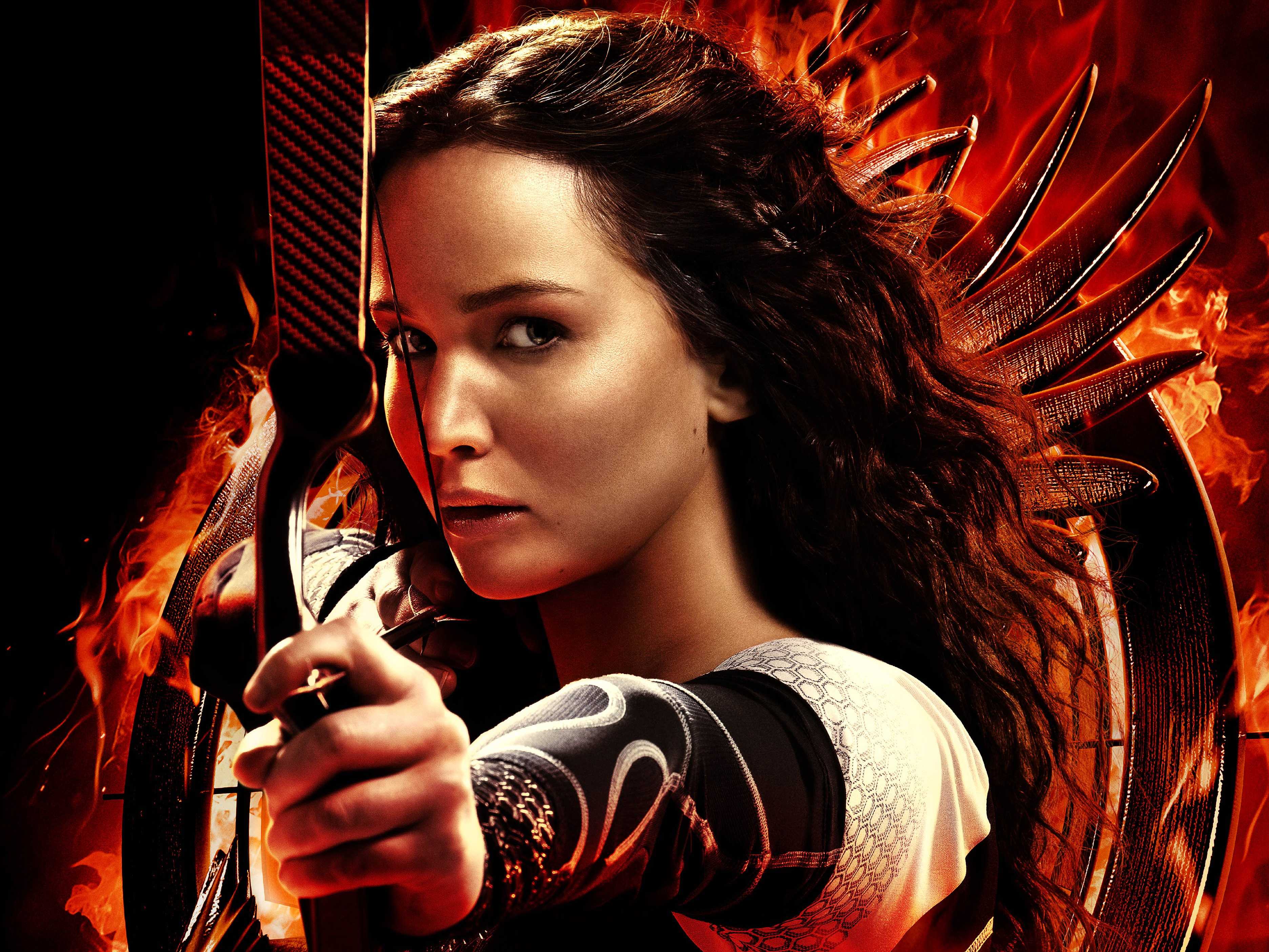
According to some, Ben Affleck gave one of the most powerful performances of his career as CIA agent Tony Mendez in the 2012 film Argo. Nonetheless, the real-life Mendez is a Hispanic man, while Affleck is… not. Once again, a role that calls for a person of color is given to a white person. This whitewashing shit is beyond annoying.
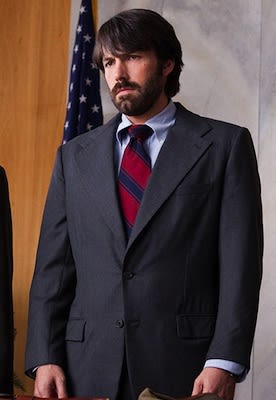
The 2013 movie Warm Bodies may have called for a half-Ethiopian actress to play the role of Nora, but the actress cast was Analeigh Tipton. No slight meant to Tipton, but the role really ought to have gone to a woman of color.

Whew! We’ve reached the end of the list. Oops. Wait a minute. This is not quite the end. The last movie on this list is actually the movie that served as the inspiration for me to write this post. Fans of the anime movie Ghost in the Shell are expressing their frustration at the casting of Scarlett Johansson as the lead in the 2017 live-action adaptation of the manga film. I’m with them. Don’t get me wrong. I love me some Scar Jo. To me, she is the perfect Natasha Romanov (the Black Widow from the Marvel Cinematic Universe), in the same way that Robert Downey, Jr. is the quintessential Tony Stark. This doesn’t change the fact that she’s going to be portraying a character of Asian ethnicity. That role ought to go to an Asian actress. Sadly, Hollywood has shown once again that they have no problem whitewashing the films they greenlight.

These racist practices (and more) have existed in Hollywood for far too long. They reinforce a cultural narrative that white lives are the ones the most important. This white bias has long been criticized, but critics are powerless to end the racist practices in the entertainment industry. They cannot prevent the continued use of yellowface, nor can they step in and ensure that roles intended for a Person of Color are played by one. Only the people in control of decisions in Hollywood can do that. The question is, when will these powerful people begin acting responsibly?
*In addition to white bias, Hollywood is also biased towards cisgender, heterosexual men.
Pushing forward
According to Merriam-Webster, diversity is defined as “the quality or state of having many different forms, types, ideas, etc”. A diverse workforce, for instance, is one in which you find people of varied backgrounds and with varied physical qualities. For many, diversity is thought of in terms of race or sexual orientation, but it goes far beyond that. According to Loden and Rosener, there are two main dimensions to diversity. Within the primary dimension are unchangeable characteristics, such as race, age, ethnicity, physical qualities, sexual orientation, and gender (the last one is changeable however–gender is not an innate quality of an individual, it is a social construct; despite the fact that one can change their gender, that is no basis for the discrimination or oppression of trans people and if you think it is, you are a shithead). The secondary dimension consists of those qualities that are not inherent. These more malleable characteristics include parental status, religious beliefs, income, education, and military experience (via Arizona.edu; source: Loden, M, & Rosener, J. (1991). Workforce America!: Managing Employee Diversity as a Vital Resource. Homewood , IL: Business One Irwin.)
That’s what diversity is, but why is it important? Why should it matter that queer people desire better representation in comic books? Why does it matter that this years Academy Award nominees were a sea of white faces? Why are people so happy that the next Ghostbusters movie will feature an all-female cast?
Other people matter. That’s why.
For too long the message from society has been that the only stories that matter, the only experiences that matter, are those of male, European-American, cisgender, heterosexuals (MEACHs). That is not true. It has never been true (though many people think it is). Recognizing that all humans have dignity and that we all matter means that our stories matter. Our histories matter. Our experiences matter. Maybe they don’t matter to MEACHs (though certainly there are many in that group who value the lives, stories, and experiences of others), but the world doesn’t consist of, nor does it revolve around that group. Unfortunately, for too long in USAmerica, almost everything has catered to the desires and wishes of MEACHs. The overwhelming majority of movies produced by Hollywood have reinforced the idea that the only people who matter are MEACHs. Our politicians have been and largely continue to be predominately MEACHs. For a long time in this country our workforce was dominated by MEACHs. The protections of the government were extended only to MEACHs for much of our history. In effect, the message sent by U.S. society is that unless you were a cisgender, heterosexual, white male, you did not matter.
Thankfully, that is changing.
Hollywood for instance, is beginning to see that there is market for and money to be made in movies featuring women.
THR reported Aug. 2 that Sony wants to launch a female-led reboot of Ghostbusters from Bridesmaids director Paul Feig. Two days later, the studio said it is targeting 2017 for a woman superhero film set in the Spider-Man universe. Marvel Studios, whose Guardians of the Galaxy lured a 44 percent-female audience on opening weekend (the biggest share of any Marvel film) is said to be close to greenlighting a Black Widow pic forScarlett Johansson. And The Expendables producer Avi Lernersaid Aug. 4 he wants to shoot a female spinoff Expendabelles in 2015 (Sylvester Stallone says he wants Sigourney Weaver to star).
Even as U.S. box office is down about 18 percent this summer, women and girls are driving some of the biggest success stories, including Maleficent ($727.5 million globally), The Fault in Our Stars ($263 million worldwide) and Lucy(a $43.9 million U.S. opening). They follow female-fronted smashes The Hunger Games and Frozen. “It used to be people would look at the success of individual titles and look at them as being the exception to the rule,” says Columbia president of production Hannah Minghella. “But I don’t think we can think that way anymore.”
Of course there is resistance to Hollywood’s diversity initiatives. The Manosphere (helpful glossary here) is filled with whiny, entitled douchenozzles. These people (largely MEACHs) weren’t happy to hear about an all-female Ghostbusters movie. While some tried to mask their sexism behind complaints like “Hollywood is ruining our childhood” and “what about nostalgia” and “women aren’t funny, how can they be Ghostbusters”, it’s plain to my eye, that they are really whining because they aren’t the only ones being catered to any longer.

Diversity in Hollywood can be seen in the upcoming Aquaman movie, featuring Jason Momoa in the title role. In the comic books, Aquaman has always been a MEACH (just like the target audience), but Momoa is Hawaiian (Kanaka Maoli to be exact). When the Aquaman movie hits in 2018, children and adults of Hawaiian background will get to see themselves represented on the big screen, something that is, to say the least, quite rare. Not only that, but they’ll get to see themselves represented in a heroic manner. This-diversity-is a good great thing and Momoa is excited, not just for himself, but his kids:
“It’s awesome as an actor to know what your future is going to be because I have children and I’ve busted my ass to put food on the table,” he says. “It’s awesome knowing that I’m going to be in Justice League because my son is the biggest Batman fan and my daughter loves Wonder Woman. It’ll be cool for them to see me in something because they’re not going to be watching Game of Thrones or Red Roadanytime soon, but now they can see Daddy kicking ass in IMAX.”
Momoa joins fellow ass-kickers The Rock and Vin Diesel as a new breed of ethnically ambiguous action hero. As a Hawaiian, it wasn’t easy for Momoa to break into Hollywood.
“I’ve had to bust ass to be in this industry. A lot of things are very black and white,” he says. “Aquamanis especially cool because being a Kanaka Maoli—being Hawaiian—our Gods are Kanaloa and Maui, and the Earth is 71 percent water, so I get to represent that. And I’m someone who gets to represent all the islanders, not some blond-haired superhero. It’s cool that there’s a brown-skinned superhero.”
Yes, it is cool. In large part because it will show that heroes can come in all races and ethnicities, not just European-Americans. This is only one step, however. Other important steps: Cyborg, starring Ray Fisher, due in 2020 and Black Panther, featuring Chadwick Boseman, in 2017. Four examples do not, of course, magically make Hollywood more diverse. Beyond superheroes and beyond increasing the on-screen presence of People of Color, women, and other minority groups, Hollywood needs more Black, Asian, Latino, and female directors, screenwriters, producers and more. Then there are the supremely underrepresented groups in Hollywood, like trans people, people with mental or physical disabilities, More. More. More. Don’t stop until Hollywood accurately reflects USAmerica, rather than just MEACHs.
The comic book industry is another area in the United States that needs to diversify. Traditionally the domain of MEACHs, mainstream USAmerican comics have diversified somewhat over the last 15 years. There are an increasing number of women creating comics. There are an increasing number of female-led comic books (for instance, Marvel currently produces Thor, Angel: Asgard’s Assassin, Storm, the Unbeatable Squirrel Girl, Ms Marvel, Captain Marvel, Black Widow, Spider-Woman, Spider-Gwen, Silk, and an all-female team of X-Men; She-Hulk and Elektra were cancelled recently). Despite this, things in the land of USAmerican comics are far from perfect, and one young girl recently decided to express her dissatisfaction with DC Comics:

The letter reads:
Dear DC comics,
My name is Rowan and I am 11 years old. I love superheroes and have been reading comics and watching superhero cartoons and movies since I was very young. I’m a girl, and I’m upset because there aren’t very many girl superheroes or movies and comics from DC.
For my birthday, I got some of your Justice League Chibis™. I noticed in the little pamphlet that there are only 2 girl Chibis, and 10 boys. Also, the background for the girl figures was all pink and purple.
I remember watching Justice League cartoons when I was really young with my dad. There are Superman and Batman movies, but not a Wonder Woman one. You have a Flash TV show, but not a Wonder Woman one. Marvel Comics made a movie about a talking tree and raccoon awesome, but you haven’t made a movie with Wonder Woman.
I would really like a Hawkgirl or Catwoman or the girls of the Young Justice TV show action figures please. I love your comics, but I would love them a whole lot more, if there were more girls.
I asked a lot of the people I know whether they watched movies or read books or comics where girls were the main characters, they all said yes.
Please do something about this. Girls read comics too and they care.
Sincerely, Rowan.
This letter expresses the feelings of many comic book fans. A DC Comics rep responded on Twitter:
Thanks Rowan. We agree, we’re working hard to create more superhero fun for girls!
— DC Comics (@DCComics) January 30, 2015
Despite the advances made in the comic book industry (which, btw, is more than just Marvel and DC; I focus on them because they are the Big 2 publishers and put out the vast majority of comic books on the racks), there is still a long way to go and the bigwigs at Marvel and DC are not the only ones who realize this. BOOM! Studios founder and CEO Ross Richie says he wants to help push comics forward:
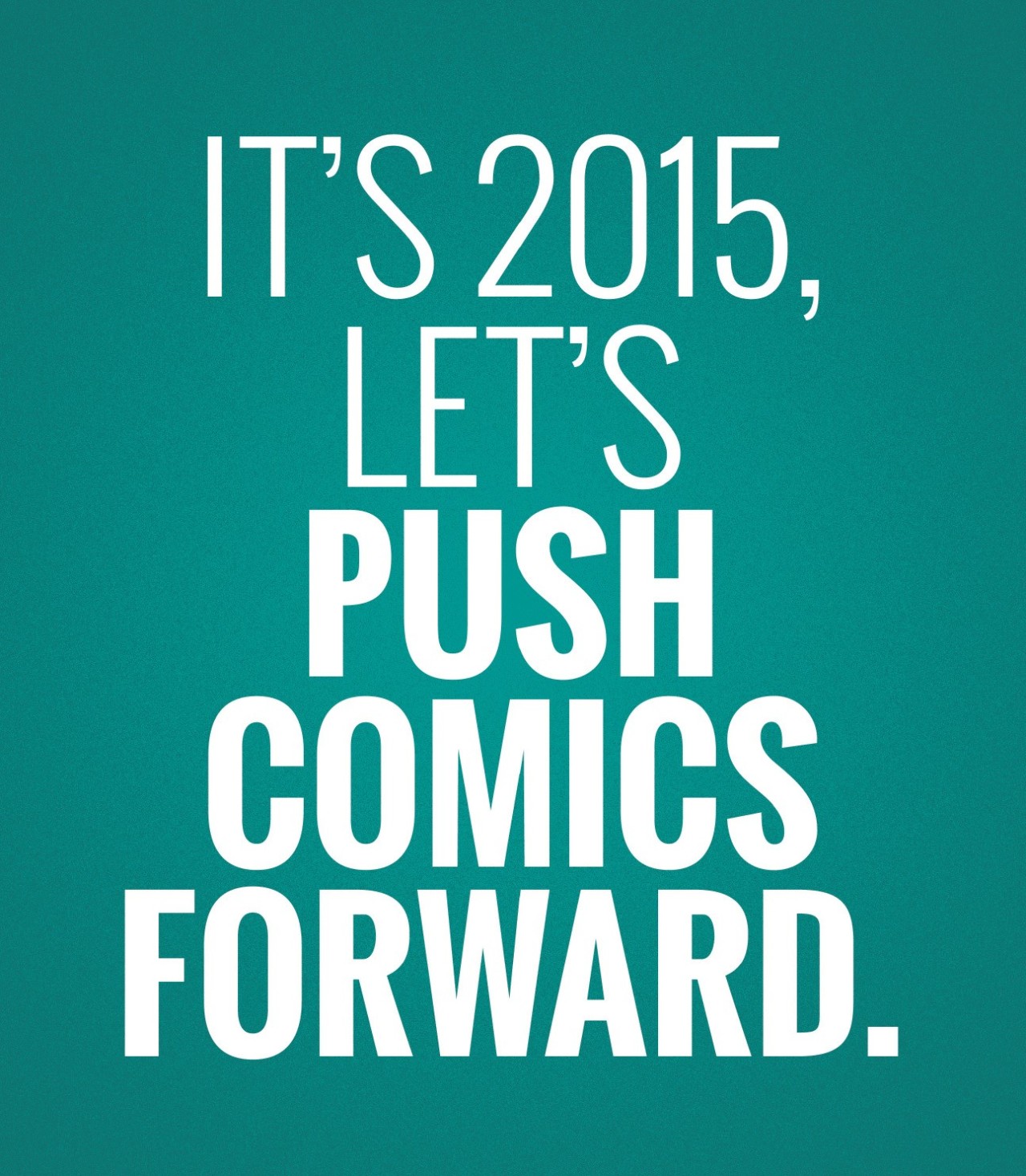
It’s Keith Giffen’s fault. I keep telling people that he talked me into it in a dive bar on L.A.’s west side. But the truth is that I started this company out of the spare bedroom in my apartment because I couldn’t believe the guy that created Rocket Raccoon thought I could do it. Maybe we could bring something to comics that hadn’t been there before?
I’ve loved comics since 1976. I never thought I’d publish them. Sure, I’d worked with giants of the field, including Barry Windsor-Smith, Howard Chaykin, Jim Starlin, Walter Simonson, and others too numerous to mention, when I was a young marketing turk at Malibu Comics 20 years ago. But me, publish comic books? You’re crazy.
So it’s 10 years later now. Comics publishers don’t often make it that far, do they? We should do a victory lap right now.
But who wants to look backward when there’s so much more cool stuff around the bend?
Let’s talk about the future.
Have you ever had a friend that shared a lot of your interests, but they didn’t read comics? You gave them Watchmen, you gave them Y: The Last Man, you gave them X-Men. But nothing stuck. They liked the idea of comics, but there wasn’t a comic book that felt like it was made for them…
Let’s go make that comic book for them. Together. As fans, as creators, as retailers, as the press, as publishers. All of us. Let’s talk about how we can allPush #ComicsForward. Because comic books should be for everyone.
We know where we’ve been—our favorite eras, our favorite characters, our favorite runs. We already know all of that. I’ve got a garage full of Silver, Bronze, Copper, and Modern Age comics and I love them.
But the medium of comics has never been more on the forefront of driving pop culture and as fans of this art form, we have a rare opportunity to take that interest to the next level and embrace an entire generation of potential fans who don’t read comics right now.
We can make a new Golden Age.
At BOOM!, we’ve carefully selected new projects in 2015 that we believe will help Push #ComicsForward. These projects will take on risky subject matter, introduce new characters from diverse backgrounds, and debut a swath of new creative voices to the industry.
Just in the first few months of 2015, we’ve launched a gaming-inspired humor comic in Munchkin, two projects that tackle the complex climate in the Middle East with Burning Fields and The Realist, five series with unique female leads (Curb Stomp, HaloGen, Cluster, Help Us! Great Warrior, and Giant Days), a period crime project (Hit: 1957), and an original graphic novel about the cutest crabs to ever start a revolution (The March of the Crabs). And we’ve only just begun. But this movement isn’t just about BOOM!, it’s about all of us. We’ll be devoting a ton of our time and energy in 2015 to work with the press, conventions, and social media channels to keep the conversation going.
If you know me, you know I’m the “Challenge Accepted!” guy. If there’s a problem that hasn’t been solved or a project that seems insurmountable, I’m the first one to jump in. This is a big challenge, but I want you to join me in taking it on.
No one thought comics targeted at All Ages was viable until KaBOOM!. Now it’s the norm. No one thought an all-female cast of characters with an all-female creative team had a shot in the Direct Market—until Lumberjanes. And who would have guessed that an oversized limited series like Memetic, starring a hearing-impaired, gay college student and a blind, African-American general about a meme-induced apocalypse, would garner rave reviews? We did.
If you believe comics are great just the way they are, this isn’t for you. If you think superheroes are the only kinds of stories worth telling in comics, this isn’t for you. But if you want to see everyone reading comics—your aunt, your co-workers, your niece, your boyfriend, that kid down the street—let’s Push #ComicsForward in 2015.
Together.
ROSS RICHIE
Founder & CEO
BOOM! Studios
This is the type of thing I want to see more of, and not just from the comic book industry. Not just from Hollywood. I want to see greater diversity everywhere. Not just for me, as a gay, black male. I want to see women represented better in society. I want to see Asian-Americans granted more prominence. I want to see the lives of Latinos treated as if they have value. As if they matter. I want to see trans people recognized as human beings with rights, and I damn sure want to see greater representation of them. Everywhere. Because they matter. That’s the lesson to be learned. Everyone matters. Not just male, European-American, cisgender, heterosexuals.
Pop Culture Link Round Up 11.22.14
Feminist Link Round Up 10.26.14
Women Break Through On TV & B.O., But Glass Ceiling Remains
Lauren Zalaznick, former topper at NBCUniversal as well as cable nets Bravo and Oxygen, noted that the most powerful show runner going right now isShonda Rhimes. “There is some movement that may be systemic or it may be cyclical, and we don’t know,” she said, noting also the unparalleled presence of shows with strong female characters who are 45-plus.
The picture in TV is brighter than in film. “I very much feel that there’s an institutional resistance to female storytelling,” said producer Lydia Dean Pilcher (The Sisterhood of Night, The Talented Mr. Ripley).
“Who can tell stories? Anyone who has a compelling story that will drive box office,” said Stacy Smith, director of the Media, Diversity & Social Change Initiative at USC’s Annenberg School.
Smith pointed to results of a study she’d conducted about the prevalence (or lack thereof) of female producers and directors across the top 100 films in Hollywood. In 2013, for instance, 1.9 percent of the top 100 films in Hollywood had a female director, down from 2.7 percent in 2007.
So what are the persistent barriers? What you might expect, the panelists suggested, from long-standing attitudes that men are better at handling “the money” to a sort of Stockholm Syndrome among women in the business who remain vastly outnumbered by men.
The gates will come down, several panelists said, not by political outreach but simply by the sheer number of female-driven stories, on TV and film, that produce undeniable business.
Um, how are the barriers going to come down if women are outnumbered in the business? I think outreach is necessary to give women the chance to produce more stories on tv and film.
* * * *
Women make up almost half of all gamers
For years, Gamescom—one of the world’s biggest annual trade exhibitions for digital gamers—has been a man’s world.
But games developers now are increasingly targeting a growing community of female gamers, as a way of boosting an industry expected to generate sales of $100 billion this year.
“We see a big and fast increase in female players, over all genres,” said Fredrik Rundqvist, a games producer at Ubisoft SA UBI.FR -0.80% ‘s Massive Entertainment studio.
Ubisoft has good reason to take notice. The company ran into controversy earlier this year when it scrapped the option to play as a female character in its coming Assassin’s Creed Unity game—an action game set in Paris during the French Revolution—slated for release this fall.
That decision—the company said including women characters would take too much production work—caused a backlash in the game world, another sign that women gamers could no longer be ignored. Ubisoft, however, has introduced a female character—albeit a nonplaying one—a Templar warrior called Elise, into the game, and has told media that its future titles will feature more diverse lead characters, without giving specific examples.
The timing seems to be right.
Female gamers made up about 48% of the game-playing public in the U.S. this year, according to a report recently published by the Entertainment Software Association, a U.S. game industry trade group.
That is up sharply from 40% in 2010. What is more, women over 18-years-old now represent a significantly larger portion of the U.S. game-playing population than boys under 18, a demographic that has traditionally been seen as a core target group for game companies. The ESA based its findings on a study of 2,200 U.S. households.
The article goes on to point out that there has been a surge in mobile gaming, which has contributed to more women playing games. Unlike gamers though (who love to claim that those who play games on their phones or tablets aren’t “true gamers”, which is a version of the No True Scotsman fallacy), the article is not distinguishing between people who play games on consoles like Xbox360 or PS4 from those who play non video games. The article includes all games, which is as it should be, bc “gaming” encompasses more than just playing games on a console. It also includes gaming online, on mobile devices, or board games. Gamers don’t like this of course, but they don’t get to decide for others if they’re a gamer or not. So they can take their shit and shove it.
* * * *
Gene Simmons thinks women should stop relying on men
Tantaros prompts the advice by bringing up a section of Gene Simmons book— Me, Inc.: Build an Army of One, Unleash Your Inner Rock God, Win in Life and Business—in which he tells women to put off having families until they establish a way to make money for themselves, because they can’t do both.
Men have to make a living, but women have the option of becoming a housewife—which only works, he says, until the man runs away. At that point, he graciously explains, “you have to balance your budget” and “you have to spend less than the amount of money that comes in.” (Unfortunately, Gene does not explain what the words “budget” and “money” mean, so I zoned out.) He continues:
“This is a very complex and difficult question to answer so I’m going to put it as simply as possible. Women: Stop depending on men. It’s as simple as that. Imagine there are no men in life. Find out that thing that you’re good for that makes the money and then get married and or have children from a position of strength.”
What a patronizing answer. Here’s a hint Gene, millions of women already knew this and are doing that very thing. Of course, institutionalized sexism presents obstacles that prevent women from attaining their goals. That’s m’ first problem.
Another problem I have is with the idea that women should find a job that pays money and then start a family. The opinion operates under the assumption that this should be a woman’s goal. I disagree. Some women want to get married and have kids. Others do not. There is no correct path for a woman to take. A woman’s life is her own. If she doesn’t want to get married or have kids. that is her choice. As a society, we need to stop pressuring women to get married and have kids. Women are in charge of their lives and they can make the decisions they feel are best for themselves without outside interference.
* * * *
Law enforcement officials violate privacy of women they’ve arrested

In yet another example of men acting as if they’re entitled to women’s bodies, a California Highway Patrol Officer is in hot water after admitting to stealing nude and semi-nude photos from the phones of women he’s arrested over the years. Worse, he shared the images with fellow law enforcement officers.
CHP Officer Sean Harrington, 35, of Martinez, also confessed to stealing explicit photos from the cellphone of a second Contra Costa County DUI suspect in August and forwarding those images to at least two CHP colleagues. The five-year CHP veteran called it a “game” among officers, according to an Oct. 14 search warrant affidavit.
Harrington told investigators he had done the same thing to female arrestees a “half dozen times in the last several years,” according to the court records, which included leering text messages between Harrington and his Dublin CHP colleague, Officer Robert Hazelwood.
Contra Costa County prosecutors are investigating and say the conduct of the officers — none of whom has been charged so far — could compromise any criminal cases in which they are witnesses. CHP Commissioner Joe Farrow said in a statement that his agency too has “active and open investigations” and cited a similar case several years ago in Los Angeles involving a pair of officers.
“The allegations anger and disgust me,” Farrow said. “We expect the highest levels of integrity and moral strength from everyone in the California Highway Patrol, and there is no place in our organization for such behavior.”
You know what? I see comments of this nature on articles about police abuses of power on a regular basis. Law Enforcement officials will express anger or disgust with the actions of police officers when they do shit like this. My question is, what steps are being taken to prevent cops from doing stuff like this? There are innumerable examples of police officers across the country abusing their power. What is being done about this? Are departments undergoing sensitivity training classes? Ethics classes? Racism classes? Or is this a case of “deal with the problem after it happens, rather than try to prevent problems in the first place”?
Rick Madsen, the Danville attorney for the 23-year-old San Ramon woman who was the first to report Harrington, said the implications of the case are “far-reaching and very damaging.”
“The callousness and depravity with which these officers communicated about my client is dehumanizing, horribly offensive and degrading to all women,” he said. “It’s going to lead to another level of mistrust and skepticism to the motive of law enforcement in general.”
Law enforcement agencies across the country, if they were interested in doing their job effectively, would see incidents like this as a sign that their agencies need to be overhauled. These problems are not unique to an agency here and there. As with the wider culture, sexism, homophobia, and racism are prevalent in the law enforcement world. It’s made worse given that they have a level of power that regular citizens do not have. Which means when they abuse that power and act in an unacceptable manner, the damage done is far greater than if the same thing were done by the average citizen.
As this newspaper first reported earlier this week, the investigation began with a single incident: Harrington’s conduct during the Aug. 29 arrest of the San Ramon woman. The woman discovered that photos had been stolen from her phone five days after her release, when she noticed on her iPad that the photos had been sent to an unknown number. A record of the messages had been deleted from her iPhone, but the phone had been synced to the iPad.
In his investigation, Holcombe compared video surveillance and time-stamped text messages from the woman’s phone and determined Harrington was in possession of the woman’s phone at the moment the photos were forwarded. The woman — who registered a blood-alcohol level of 0.29 percent, more than three times the legal limit — was being processed in the Martinez County Jail when the photos were stolen, according to court records.
During questioning, Harrington admitted to stealing five photographs from the woman and said he forwarded at least one to Hazelwood, according to court records.
Reached by phone by this newspaper on Friday, Hazelwood declined to comment. Messages to the other two officers were not returned.
“Harrington said he first learned of this scheme when he was working in the Los Angeles office,” Holcombe wrote in the affidavit. “Harrington said when he was assigned to the Dublin office, he learned from other officers that they would access the cell phones of female arrestees and look for nude photographs of them. Harrington said if photographs were located, the officers would then text the photographs to other sworn members of the office, and, to non-CHP individuals. Harrington described this scheme as a game.”
A game.
Violating the privacy of women is a game to this pissant. Faith in humanity -1000.
* * * *
I can’t believe it’s 2014 and people are still being hung
A 26-year-old Iranian woman convicted of murdering a man she accused of trying to rape her as a teenager was hanged on Saturday, the official news agency IRNA said, despite international pleas for her life to be spared.
Reyhaneh Jabbari walked to the gallows at dawn on Saturday in Tehran’s Evin prison after failing to secure a reprieve from the murder victim’s relatives within the 10-day deadline set by sharia law in force since the 1979 Islamic Revolution.
The death sentence sparked U.S. and European Union condemnation and the government of President Hassan Rouhani, who won election last year on promises of liberal reform at home and easing Iran’s isolation abroad, to intervene to get it commuted.
Justice Minister Mostafa Pour-Mohammadi said in early October that a “good ending” was in sight, but official media reported later that the slain man’s family could not be persuaded to approve leniency for Jabbari.
Jabbari was sentenced to death in accordance with Koranic “qisas”, or eye for an eye, law after being found guilty of stabbing dead an older man with a kitchen knife in 2007.
This is retributive justice and it violates the right to life that all human persons possess. No higher purpose was served in killing Jabbari. Her attempted rapist isn’t brought back to life. All that’s left are two devastated families, rather than one. How in the world does this make the world, or even just Iran, a better place?
I despise ‘eye for an eye’ “justice”. It focuses on payback, or revenge for actual or perceived crimes. It also violates the human rights we all possess. It’s a barbaric form of “justice” yet people keep embracing it. Perhaps it’s because punitive justice is preferred to rehabilitative justice, but it’s a shame no matter the reason. Another reason for my opposition to retributive justice: there are enough people in the world suffering and dying and such barbarism only contributes to more of the same. I want to live a life with minimal amounts of suffering and anguish and I want the same for everyone else, so I oppose things like retributive justice and capital punishment. Part of the efforts of social justice activists is to make the world a better place. Part of that is reducing violence. There’s also the problem of governments killing their own citizens. That stands at odds with the function of government, which is (in part) to protect its citizenry, not to kill them. I long for the day when retributive justice is consigned to the dustbins of history.



